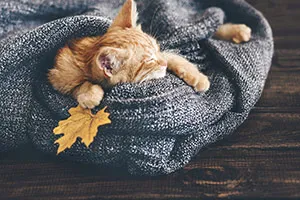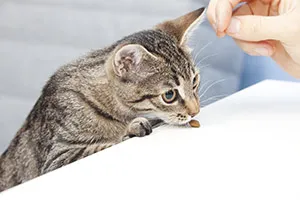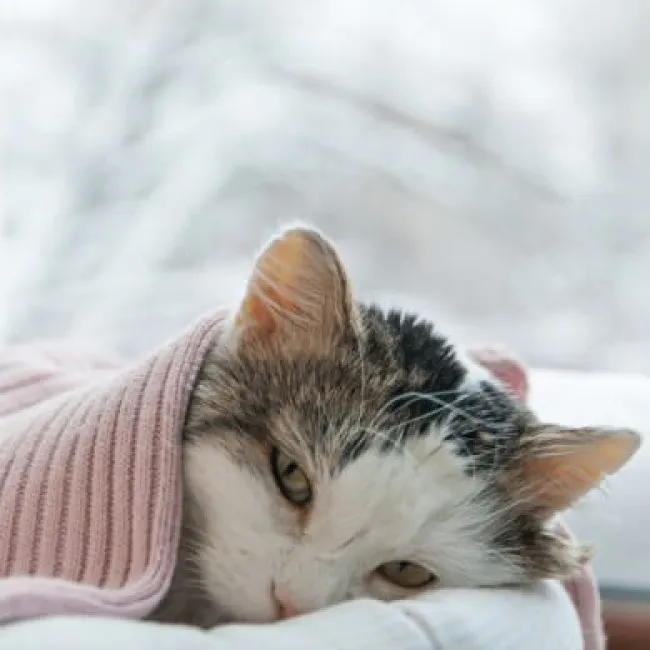How to Clean Cat Ears
- Why do I need to clean my cat’s ears?
- Understanding your cat’s ears
- Checking cat ears
- How to clean cat ears
- Why use a pet ear cleaner?
- Can I clean my kitten’s ears?
- How often should I clean my cat’s ears?
- Cat ear cleaning tips
- Blanket method
- Get some help
- Never use a cotton bud
- Have treats!
- Patience is purrfect
When it comes to the health and wellbeing of your cat, there are many areas that may seem small but can make a big difference. Ear cleaning is one of these important rituals and should be a regular part of your cat grooming routine. Cat ears are a complex thing and require maintenance just like ours do to keep them healthy. To help you clean dirty cat ears prevent any potential issues from arising, here are some handy tips on how to clean cat ears.
Why do I need to clean my cat’s ears?
Have you ever had a buildup of wax in your ear and it has affected your hearing? Well, this can also happen for your cat! Wax, dirt and debris can easily build up and block their ear canal, leading to difficulty in hearing and other issues. In general, cats are pretty good at keeping themselves clean and well groomed, and their ears do have their own natural cleaning mechanisms. There are many times, however, where cat ear problems can arise that they can’t deal with themselves such as mites, infections and blisters. To help deal with these when they occur and to reduce the risk of them happening, regular ear cleaning should be made a part of your grooming schedule.
Understanding your cat’s ears
Before you start blindly poking around and causing damage when trying to clean your cat’s ears, you need to learn about their anatomy. Firstly there is the outer ear which is split into two parts - the pinna and the ear canal. The pinna is the visible outside part of the ear that is covered in fur and the canal is the sensitive ‘tunnel’ to the inner ear. Inside cat ears there are similar parts to humans, such as the eardrum and the inner ear where they process sounds and keep their balance. This part is extremely important as it is not only where they hear sounds but also allows them to successfully jump to great heights! When cleaning their ears, therefore, you need to make sure you respect their complexity and clean out any wax, dirt and debris to keep them healthy.
Checking cat ears
The first step to cleaning cat ears is to take a look. This may seem simple but by doing this you can see if there are any issues you need to take care of. Start by looking on the outside of their ear for any visible dirt, cuts, swelling or bald patches. Outer ear issues could simply be a scratch that will heal itself, but something like swelling could be a symptom of a larger issue which may need a vets attention. Finding parasites, especially ear mites, cannot be simply removed by cleaning and will need a specific parasite killer product to help get rid of them. After this, look inside their ear for wax buildup and any changes in the ear structure or any bad smells that could suggest a bacterial infection. Any major issue will need separate attention and means you need to take extra care before cleaning.
How to clean cat ears
If you do not see any medical issues and just a pair of dirty cat ears, then you can begin cleaning! Begin by assembling any tools and products you may need. This can include treats, tissues, and cotton wool. To make ear cleaning easier, you’ll also need your best friend - a natural ear cleaner specifically for pets! Then you can begin:
- Make sure your cat is feeling calm and relaxed and if they particularly do not like their ears being cleaned, you may need someone else to carefully hold them.
- If there is anything on the outside of their ear, use warm water and a cotton ball to gently wipe it away off their fur.
- For the inside, place a few drops (or as instructed by the product) of ear cleaner directly into their ear. Gently massage the base of their ear to dislodge any wax or dirt.
- Remove any dirt with some cotton wool and let them shake their head if needed to get rid of anything you can’t safely reach.
- Using a tissue, gently wipe the outside and inside of their ear to remove any leftover wax, dirt or solution.
- Don’t forget to finish cleaning by rewarding them with praise, strokes and yummy treats!
Why use a pet ear cleaner?

Cat ear cleaners are your saviour when it comes to safely washing out cat ears! Many people think they don’t need to bother and that simple water will be okay - they’re wrong! Water sits in the ear and makes the perfect condition for yeast to grow which will then lead to a nasty cat ear infection. Proper ear cleaners are carefully formulated to cleanse out any dirt and wax in your cat’s ears but then quickly dry, leaving them clean and healthy. So how do you know which one to choose? When choosing your ear cleaner there are a few things to look out for.
The most important thing when choosing an ear cleaner is to make sure you look at the ingredients! Chemical-ridden cleansers may quickly dry but can cause irritation and hurt your poor furry friend. Instead, opt for a natural cat ear cleaner that uses a careful combination of botanical ingredients that are non-irritating and non-toxic. Some great natural ingredients you want to find include ones that will protect against bacteria and that are anti-fungal such as tea tree oil and witch hazel, those that protect their natural immunity such as echinacea and those that can be gentle and soothing such as aloe vera. In addition to looking for natural ingredients, you should also make sure that it is specifically for pets. There are plenty of human ear drops available on the market, but these will have different formulations and applications, so it is best to choose one that is specifically for animals.
Can I clean my kitten’s ears?
Yes! Kitten’s ears can be smaller and more delicate, but can still get dirty! They do, however, require some more time and attention due to the intricacies compared to adult cat ears. When dealing with a kitten, make sure to only use a gentle ear cleaner and that you take your time so as not to scare them or cause any harm. An adult cat may also be used to ear cleaning, so it can take more patience when it comes to kittens. If you can master this part of grooming at a young age though, it can make it far easier to clean their ears throughout their lives as they will feel more relaxed and know what to do.
How often should I clean my cat’s ears?
Just like the rest of your regular grooming routine, you should be checking your cat’s ears for any issues or abnormalities on a regular basis. This should usually be on a weekly basis and simply involves having a quick look on the outside and inside of their ears. When you should actually clean your cat’s ears though really depends on your cat and their needs. Most of the time cat ears can clean themselves, but you can always assist every so often to help prevent any potential cat ear problems from occurring. If you notice any sort of issue, especially a cat ear infection, after consulting with a vet, this will usually require daily cleaning to help get rid of the issue or infection.
Cat ear cleaning tips
When it comes to cleaning dirty cat ears, it really just takes practice and regular use to get the technique and method right for you. Here are a few handy tips that can help, and can be especially useful if you are a first-timer or still trying to figure out the best ear cleaning technique:

Blanket method
If your cat tends to squirm and wriggle around when cleaning their ears, try wrapping a blanket around them. This can not only help them to keep still but can also help them to feel safe and secure. Just make sure that it isn’t too tight and that it doesn’t hurt them!
Get some help

If you don’t want to use a blanket, it can be useful having a second person to hold your cat still so that you can focus on getting their ears cleaned and not causing any harm or damage from multitasking.
Never use a cotton bud
When cleaning out the inside of their ears (only the outer ear flap) as this can push dirt down even further and cause unseen damage to their delicate ear canal.
Have treats!

Make sure to have plenty of treats on hand at all times when cleaning. For some cats they may need a bit more encouragement to keep still so giving them treats as you go along can be great motivation.
Patience is purrfect
Finally, have patience! Cat’s don’t understand that you are just trying to help so don’t be mad if they try to get away or won’t keep still. Try using soothing words, giving treats and being as gentle as possible to make it as easy as you can for both you and your feline friend!





















